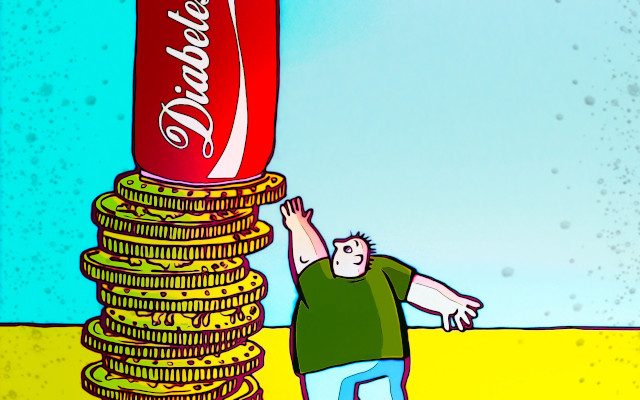The tax on sugary drinks (sugar tax) reduces obesity among British girls. This is what emerges from the study conducted by a team of researchers led by the University of Cambridge. (1)
La sugar tax anti obesity
in 2020, in England juvenile obesity affected 10% of 4-5 year olds and 20% of 10-11 year olds.
The data unfortunately it concerns the whole European population. From 5 to 9 years, almost one in three children (29,5%) is overweight and/or obese, one in eight (11,6%) already afflicted with morbid obesity, as reported by WHO Europe 2022. (2)
In Italy, Istat statistics are similar. Already in the students of the first elementary classes (7-8 years) there is an incidence of obesity of 18%, while more than one in four (25,2%) aged 3-17 is overweight. (3) Obesity, it should be remembered, is the antechamber of various non-communicable pathologies, NCDs, such as diabetes and hypertension.
To make a difference are health policies. While Italy continues to postpone the adoption of the sugar tax (la budget law 2023 postpones its adoption to 2024), the United Kingdom introduced a sugar tax in April 2018 designed to incentivize producers to reformulate soft drinks with a high sugar content.
The producers and importers into the UK are subject to a two-level tax:
– 0,24 pounds/litre (0,27 euros/l) on soft drinks containing at least 8 g of sugar per 100 ml,
– 0,18 pounds/litre (0,20 euros/l) on soft drinks containing 5 to 8 g of sugar per 100 ml.
From the mechanism milk, milk-based drinks, 100% fruit juices and powders for preparing drinks are exempt.
Encouraged the reformulation of recipes
The authors of the research under consideration report that the sugar tax led to a major reformulation of the soft drinks available on the UK market.
The percentage of drinks containing >5g sugar/100ml fell from 49% to just 15% between September 2015 and February 2019, with reformulation accelerating after the announcement in 2016 of the decision to introduce sugar tax.
The inevitable increase in price of reformulated drinks has only partially passed on to consumers. For drinks containing 5 to 8 g of sugar per 100 mL, approximately one-third of the levy was transferred.
Just the forecast of attributing the largest share of the tax burden to industry has favored reformulation, note the researchers, who cite the lower effectiveness of the sugar tax in Mexico, entirely borne by consumers, with an average price increase of 14%.
Less than 5 thousand cases of obesity among girls
To evaluate the effects of sugar tax on youth obesity, in the 19 months following the introduction of the tax measure, the researchers monitored obesity levels in over one million primary school children, divided into two groups (4-5 years and 10-11 years).
The result is that the incidence of obesity cases decreased by 8% in 10-11 year old females. A sign equivalent to the prevention of 5.234 cases of obesity per year.
The best outcome emerged among female students in schools in the most disadvantaged areas, confirming the evidence that socio-economic conditions strongly influence the quality of the diet.
No changes in the percentage of obese young people it was instead highlighted for males of the same age (10-11 years) and in the youngest (4-5 years) of any gender.
The damages of marketing
The different imprint of sugar tax on the obesity of young males and children is associated by researchers with some hypotheses:
- The smallest (4-5 years old) mainly consume fruit juices, excluded from the application of sugar tax although they contain similar amounts of sugar as sugary drinks. The same goes for sweets, biscuits, desserts and cakes, very popular among the little ones but exempt from the sugar tax,
- males 10-11 year olds watch more TV than contemporary females. They are therefore more conditioned by the marketing of sugary drinks and junk food with a high energy density and low in nutrients, always advertised as useful for increasing physical performance, as also denounced by the WHO. (4) The even virtuous Health and Care Bill, moreover, does not tighten enough the stitches of the check on the marketing di junk food aimed at minors, as we have seen.
- the girls Furthermore, 10-11 year olds are generally more likely to make healthier dietary choices (consuming more fruit and vegetables and less energy-dense foods) and adopt healthy behaviors (such as brushing their teeth).
'This highlights that, in addition to the SDIL (sugar tax, ed), they must be implemented further obesity reduction strategies evidence-based to improve weight outcomes, especially in boys and younger children, as they enter primary education', the researchers conclude.
Marta Strinati
Footnotes
(1) Rogers NT, Cummins S, Forde H, Jones CP, Mytton O, Rutter H, Sharp SJ, Theis D, White M, Adams J. Associations between trajectories of obesity prevalence in English primary school children and the UK soft drinks industry levy: An interrupted time series analysis of surveillance data. PLoS Med. 2023 Jan 26;20(1):e1004160. doi:10.1371/journal.pmed.1004160. PMID: 36701272; PMC ID: PMC9879401.
(2) Sabrina Bergamini, Dario Dongo. Obesity, childhood obesity and marketing. WHO Europe 2022 report. GIFT (Great Italian Food Trade). 16.6.22
(3) Dario Dongo, Sabrina Bergamini. Childhood obesity, 1 minor out of 4 at risk in Italy. Istat report. GIFT (Great Italian Food Trade). 29.19.19
(4) Sabrina Bergamini. Food marketing promotes unhealthy diets for children and teens. WHO report. GIFT (Great Italian Food Trade). 28.2.22

Professional journalist since January 1995, he has worked for newspapers (Il Messaggero, Paese Sera, La Stampa) and periodicals (NumeroUno, Il Salvagente). She is the author of journalistic surveys on food, she has published the book "Reading labels to know what we eat".




